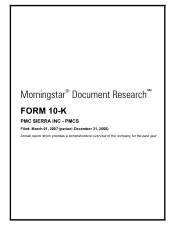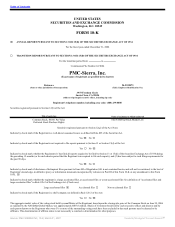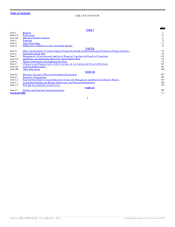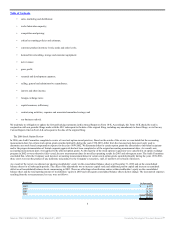Adaptec 2006 Annual Report Download - page 8
Download and view the complete annual report
Please find page 8 of the 2006 Adaptec annual report below. You can navigate through the pages in the report by either clicking on the pages listed below, or by using the keyword search tool below to find specific information within the annual report.
Table of Contents
telecommunications industry, and traditionally our sales in these areas have represented the majority of our annual revenues (approximately 70% in 2005). Our
products and solutions that are sold into the Enterprise Storage, Enterprise Networking and Customer Premise areas are driven primarily by the capital spending
of corporations, enterprises, and smaller businesses, and our sales in these areas have represented a smaller portion of revenues (approximately 30% in 2005). In
2006 the mix of our revenues shifted to approximately 50% from the telecommunications market and 50% from the enterprise and storage markets. This shift
occurred primarily as a result of the acquisitions we completed during the year.
In 2006 we acquired the Storage Semiconductor Business from Avago Technologies Inc. We purchased the Storage Semiconductor Business due to the market
position it had in the Fibre Channel Controller market and the growth opportunities for standard semiconductor solutions in the enterprise storage market. Since
the acquisition we have experienced the benefits from product synergies between the acquired business and PMC-Sierra’s disk interconnect storage IC business.
In 2006 we also purchased Passave, Inc., a company that develops system-on-chip semiconductor solutions for the Fiber To The Home (FTTH) access market.
We purchased Passave due to its market share leadership in Passive Optical Networking (PON) solutions for central office and customer premise FTTH
applications.
The general market areas that we currently serve and some typical equipment in those markets that may contain our semiconductor solutions are described below.
Due to the complexity of the telecommunications network, it is not possible to sharply delineate networking functions or markets served. In addition, many of our
products may be used in multiple classes of networking equipment that are deployed across all of the market areas identified below, while some of our other
products have highly specialized applications. For example, our microprocessors can be used in many networking equipment applications (such as color laser
printers or high-speed routers), while a single wireless infrastructure chip may only be used in one specific application (e.g., pre-distortion of power amplification
for a wireless base station). In some situations, different OEMs might use solutions in equipment addressing more than one of the market areas noted below.
Further, during the lifecycle of their products, our customers may redesign their products and exclude our devices from the new design. We are not always aware
when customers undertake such actions.
Access
The access area of the telecommunications network infrastructure encompasses both wired and wireless equipment that aggregates data traffic from homes and
businesses and transmits it to the central offices in the metro and the wide area network (WAN). Our semiconductors are used in the access area of the network in
equipment such as SONET/SDH add-drop multiplexers (which add and drop signals or streams of data from optical networks) and switches (which direct the
data traffic to other destinations within the network). Two key industry protocols that help in packaging information into formats for transportation across various
networks are Asynchronous Transfer Mode (ATM) and Internet Protocol (IP). As networks slowly converge over time, more data-centric and hybrid
multi-service equipment is required to handle IP, ATM and multi-protocol traffic.
Another technology used in the access area is Digital Subscriber Line (DSL), which allows for high-speed data communication over existing copper telephone
lines between end-users and
6
Source: PMC SIERRA INC, 10-K, March 01, 2007 Powered by Morningstar® Document Research℠





















